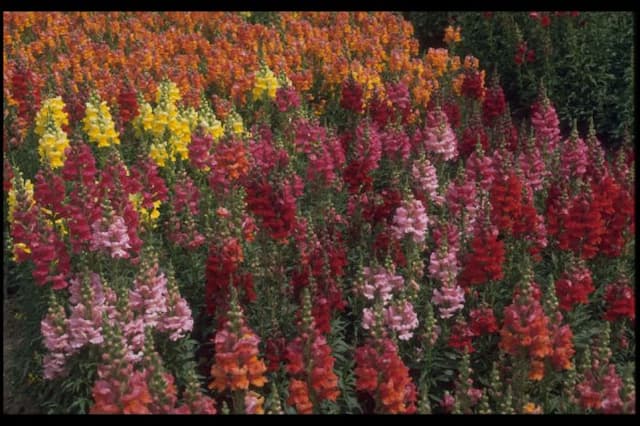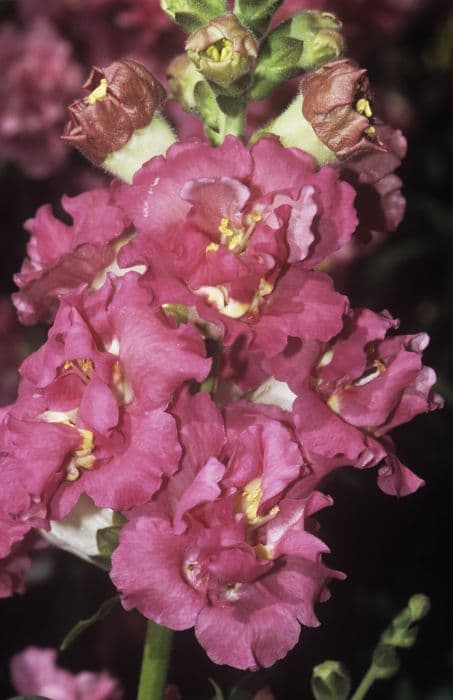Blue Gem Hebe Hebe × franciscana 'Blue Gem'

ABOUT
The 'Blue Gem' is a decorative evergreen shrub with a lush, rounded shape. Its foliage is notable for its glossy, lance-shaped leaves that bear an intense green hue. These leaves create a dense, textural appearance that serves as an attractive backdrop throughout the year. Blooming profusely in the warmer months, the plant exhibits spikes of small, tubular flowers which exhibit a striking blue to violet coloration, infusing gardens with a pop of cool-toned vibrancy. The blossoms of the 'Blue Gem' are especially appealing to bees and butterflies, which are drawn to their rich nectar. The floral display not only adds visual interest but also supports local pollinators. After flowering, the plant may produce small capsules, although these are not typically its main attraction. The overall shape and texture of the 'Blue Gem' make it a versatile choice for garden borders, mass plantings, or as a feature in a mixed shrub border. Its sturdy nature and evergreen leaves ensure it remains a focal point even when not in bloom.
About this plant
 Names
NamesFamily
Plantaginaceae
Synonyms
Blue Gem Hebe, Shrubby Veronica
Common names
Hebe × franciscana 'Blue Gem'.
 Toxicity
ToxicityTo humans
The Blue Gem is not commonly known to be toxic to humans. However, as with many plants, it is advisable to avoid ingesting any part of it because not all plant toxicities are well documented, and individual allergic reactions or sensitivities can occur. If any part of the plant is ingested, it is recommended to watch for any signs of discomfort or allergic reactions and seek medical attention if symptoms develop.
To pets
The Blue Gem is not widely recognized as toxic to pets either. However, pets can have varying sensitivities, and it is generally a good practice to prevent pets from ingesting plants. If a pet does consume any part of the Blue Gem, monitor for any signs of gastrointestinal upset or abnormal behavior, and consult with a veterinarian if any concerning symptoms arise.
 Characteristics
CharacteristicsLife cycle
Perennials
Foliage type
Evergreen
Color of leaves
Green
Flower color
Blue
Height
3 feet (0.91 meters)
Spread
5 feet (1.52 meters)
Plant type
Shrub
Hardiness zones
9
Native area
New Zealand
Benefits
 General Benefits
General Benefits- Attracts Pollinators: Hebe 'Blue Gem' attracts bees, butterflies, and other beneficial pollinators to the garden.
- Low Maintenance: Once established, this shrub requires minimal care, making it ideal for gardeners seeking low-maintenance plants.
- Drought Tolerance: It is relatively drought-tolerant, which is useful for water conservation in drier climates.
- Evergreen Foliage: Provides year-round interest with its evergreen leaves, offering a permanent structure in the garden.
- Compact Growth: Its compact size is useful for small gardens, borders, and containers where space is limited.
- Ornamental Value: Offers ornamental appeal with its striking blue to violet flowers and attractive foliage, enhancing the aesthetic of any landscape.
 Medical Properties
Medical PropertiesThis plant is not used for medical purposes.
 Air-purifying Qualities
Air-purifying QualitiesThis plant is not specifically known for air purifying qualities.
 Other Uses
Other Uses- The Blue Gem can be used as a natural dye source, with leaves producing subtle green hues on fabrics when properly treated.
- Insects such as bees and butterflies are attracted to the Blue Gem, so it is often used to support local pollinator populations in gardens and urban spaces.
- The dense foliage of the Blue Gem can be used as a privacy screen, effectively blocking views into a garden or property.
- The plant's woodsy and slightly resinous scent can be harnessed by placing cuttings indoors for a mild natural fragrance.
- Creative gardeners sometimes use the Blue Gem in topiary, training the plant into decorative shapes for aesthetic garden designs.
- This plant is occasionally included in educational projects for children to teach them about plant growth habits and botany.
- A Blue Gem's cuttings can be used as a natural rooting hormone source when placed in water, encouraging the propagation of other plants.
- Its colorful year-round appearance makes the Blue Gem suitable for use in holiday decorations and wreaths for an unconventional natural touch.
- Blue Gem can be planted as a companion plant to vegetables, offering protection by drawing pests away with its attractive foliage.
- Photographers and artists may use Blue Gem as a subject or background due to its vibrant flowers and lush green foliage for visual compositions.
Interesting Facts
 Feng Shui
Feng ShuiThe Hebe plant is not used in Feng Shui practice.
 Zodiac Sign Compitability
Zodiac Sign CompitabilityThe Hebe plant is not used in astrology practice.
 Plant Symbolism
Plant Symbolism- Youthful Vigor - Hebe was the goddess of youth in Greek mythology, and plants named after her are often associated with retaining or celebrating one's youthful qualities.
- Everlasting Beauty - With its enduring and attractive foliage and flowers, 'Blue Gem' suggests a beauty that stands the test of time.
- Protection - In certain traditions, Hebe plants are thought to offer protective qualities, possibly because of Hebe's role in mythology as a cupbearer to the gods, serving nectar that was also ambrosia, the food of the gods that was thought to confer immortality.
- Unity - As 'Blue Gem' is a hybrid, it symbolizes the unification of different qualities to create something new and beautiful.
 Water
WaterShrubby veronica should be watered deeply, allowing the soil to become dry to the touch between waterings. This typically means watering about once every week, but this can vary depending on the climate and soil conditions. Generally, during the summer, it might need more frequent watering, especially if the weather is hot and dry. Provide approximately one to two gallons of water per plant for each watering session to ensure the root zone is thoroughly moistened. During the winter months, reduce watering to every other week, as plant growth slows down and the plant requires less moisture.
 Light
LightShrubby veronica thrives in full sun to partial shade. The best spot for this plant is a location where it can receive at least six hours of direct sunlight a day but is also shielded from the harsh afternoon sun, especially in hotter climates. An east or west-facing garden that provides morning or late afternoon sunlight is ideal for promoting healthy growth and flowering.
 Temperature
TemperatureShrubby veronica prefers moderate to cool climates and can survive temperatures down to about 20 degrees Fahrenheit. However, the ideal temperature range for thriving growth is between 50 and 70 degrees Fahrenheit. Protecting the plant from frost is important for survival, and providing insulation or shelter during the coldest months can be beneficial.
 Pruning
PruningPruning shrubby veronica is important to maintain its shape and encourage bushier growth. Prune in the late winter or early spring before new growth starts. Deadheading, or removing spent flowers, can promote additional blooming. Pruning can be done annually, and it's the best time to cut back any frost-damaged branches to ensure healthy new growth in the spring.
 Cleaning
CleaningAs needed
 Soil
SoilThe Shamrock Hebe thrives in well-draining soil with a compost and peat moss blend, preferring a slightly acidic to neutral pH of 6.5 to 7.5. A top dressing of bark chips can help to maintain appropriate soil conditions.
 Repotting
RepottingShamrock Hebe should be repotted every 2 to 3 years to replenish the soil and provide room for growth. It is best done in spring or early summer when the plant is entering a period of active growth.
 Humidity & Misting
Humidity & MistingThe Shamrock Hebe prefers moderate humidity levels but is quite adaptable. It can tolerate the average humidity found in most homes without the need for special attention.
 Suitable locations
Suitable locationsIndoor
Ensure bright indirect light, avoid overwatering, and maintain moderate humidity for indoor Shamrock Hebe.
Outdoor
Plant in sun to partial shade, protect from extreme cold, and ensure soil drains well for Shamrock Hebe.
Hardiness zone
8-10 USDA
 Life cycle
Life cycleThe life of Hebe 'Blue Gem' begins with seed germination, which occurs in a moist, well-draining soil environment with adequate light. Once sprouted, the seedlings grow into juvenile plants, developing a dense, bushy habit with glossy leaves. As the plant matures, it enters the flowering stage, usually in early summer, producing clusters of small blue to violet flowers that are attractive to pollinators. After pollination, flowers may develop into small, inconspicuous, dry capsules containing seeds, completing the reproductive cycle. The plant will continue to grow and may require pruning to maintain its shape and promote vigorous growth. Hebe 'Blue Gem' has an average lifespan of several years, although it can be shorter in colder climates where it is not hardy.
 Propogation
PropogationPropogation time
Spring-Early Summer
Hebe 'Blue Gem', often known simply as a Hebe, is a popular evergreen shrub prized for its beautiful blue flowers and glossy foliage. The most popular method of propagation for this plant is by semi-hardwood cuttings. This process usually takes place in late summer. A gardener would select healthy, non-flowering stems and cut sections about 4-6 inches (10-15 cm) long, just below a leaf node. Leaves on the lower half of the cutting are removed and the cut end is dipped in rooting hormone before being planted in a mix of perlite and peat moss. The cutting should be kept moist and in indirect light until roots develop, which typically occurs within a few weeks to months. Once the cutting has established a strong root system, it can be transplanted to a more permanent location.





![Snapdragon [Pretty in Pink]](/_next/image?url=https%3A%2F%2Fplants-admin.emdemapps.com%2Fimages%2Fplants%2F%2Fimages%2F604b5cb3b5385.png&w=640&q=75)



